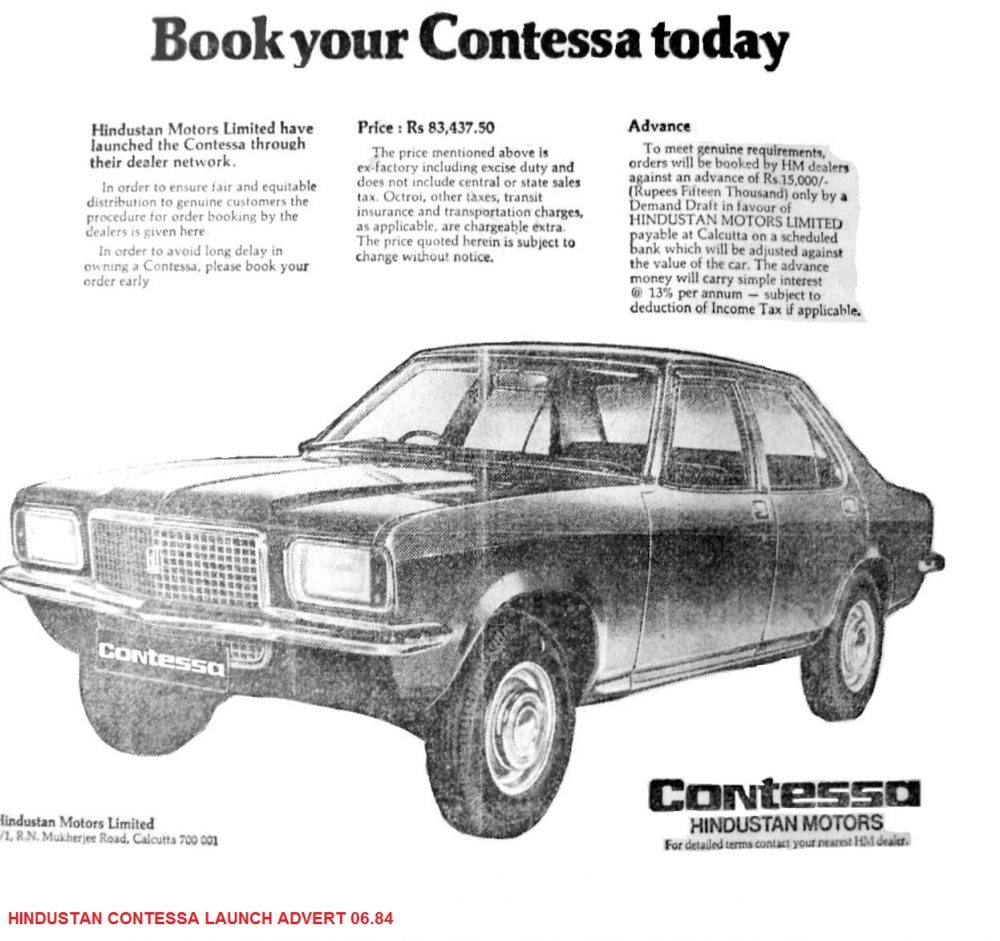Forgotten Brands – HM Contessa

The Contessa from Hindustan Motors was the go-to muscle car. At that time, it was perceived as a premium, spacious car
By the late 1970s, HM was ready to introduce a more modern car to the Indian market. The only other car they had in production at that time was the Ambassador, which was based on the 1956 Morris Oxford III, introduced in 1958 and had been largely unchanged since.
Vauxhall
When production of the FE VX Series finished in July 1978, Vauxhall, in common with all motor manufacturers, was legally bound to supply body parts and panels for the cars up to five years after production ceased and ten years in the case of service items such as brakes, headlights, etc. In the case of service parts, it was not too much of a problem because the Bedford CF would continue to use the engine until 1984, and then Vauxhall would need to supply parts until 1994.
However, Hindustan Motors approached Vauxhall in 1979. Hindustan wanted all the tooling and presses for the entire body, some ancillary systems, and also the dashboard assembly, which then left Vauxhall with the problem that they would risk not being able to honour their legal obligation to supply some body parts. The solution was interesting, as Hindustan was not planning to start series production until 1984 and so agreed to supply any body panels that Vauxhall needed, although a large stockpile had been built up by the Vauxhall Parts Centre at Toddington before the tooling was shipped to India in 1980. The cost to Hindustan was £1.5 million, including all the blueprints for manufacture.
Naming
HM took the name “Contessa” from the Japanese Hino Contessa, a pickup vehicle that Hino produced between 1961 and 1969.
Production
The production line was set up alongside the Ambassador at Uttarpara, near Kolkata, and the first test cars were ready by 1982. The series production was underway by the spring of 1984.
To keep development costs in check, the HM Contessa was introduced to the Indian market with the 50 hp (37 kW) 1.5 L BMC B-Series engine, which also powered the Ambassador in a slightly modified form, along with the Hindustan four-speed gearbox, both from the early 1950s. The Contessa was thus a car introduced in 1984 with a 1970 body and a 1950 engine and gearbox. The press was upbeat about the roomy interior and plush ride but critical of the grossly underpowered engine and equally primitive gearbox. The top speed was only around 125 km/h (78 mph), although there was also a version with higher 8.3:1 compression that offered 54 hp (40 kW).
Back in the day, Hindustan Motors had a very basic manufacturing plant. Its cars were mostly hand-built. This hampered the production output & finish and kept the manufacturing cost higher than the rivals.
Isuzu-Engine Era
Sales got off to a slow start, with most cars going to government and municipal officials, where the complete lack of performance was not a hindrance. Hindustan knew that any further development of the B Series engine would give limited results, so in 1985, Hindustan started negotiations with Isuzu of Japan to locally manufacture engines and gearboxes for use in the Contessa and later in the Ambassador. These negotiations were concluded in August 1986 and gave Hindustan the rights to locally produce the Isuzu 1.8-litre 4ZB1 petrol engine and associated 5-speed gearbox.



In October 1987, Hindustan launched the revised Contessa Classic 1.8GL with a new engine and gearbox, along with an updated grille and bumpers. The car was an instant sales success and set new standards for refinement, power, and luxury in the Indian market; the ex-BMC engine was dropped at the same time. The basic design of the Contessa remained essentially the same throughout the model’s life, although there were minor updates to the specification with items such as power windows, power steering, larger bumpers, updated headlights, and air conditioning, all to keep the Contessa competitive in the Indian premium car market.
In the 1990s, Hindustan started manufacturing the 2.0-litre Isuzu 4FC1 diesel engine that came to power the Contessa Diesel. The diesel was a reasonably strong seller, considering its high price. A turbo-diesel version was introduced a few years later.
However, after the advent of more modern cars from GM, Ford, Fiat, Tata, etc., the demand for the Contessa began to wane. Maruti Suzuki had grabbed the lion’s share of the market, and intense competition between the new auto manufacturers brought modern fuel-efficient cars to the Indian marketplace in the late 1990s. The constant rise of petrol prices was the final nail in the coffin for the now comparably thirsty Contessa, which was phased out in 2002.
HM has since sold the brand to SG Corporate
Trivia
Due to its boxy design and rear-wheel-drive format, the Hindustan Contessa was also referred to as the muscle car of India.
Reference
http://vauxpedianet.uk2sitebuilder.com/vauxhall-fe-v72-94000—vx-series-aka-hindustan-contessa
https://www.autopunditz.com/post/gone-but-not-forgotten-contessa



